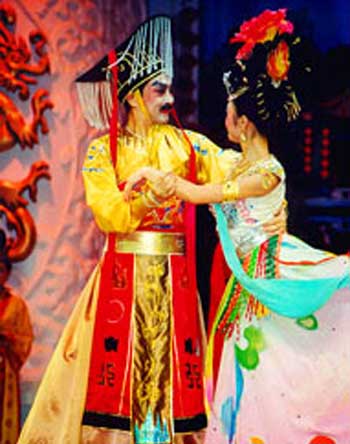| Legole.Com Discover china. Explore the beauty and wonder of the land, people, and culture of China. |
 |
|
|
 |
 The Tang Dynasty Dinner Show, a performance of Chang'an music and dance originated in China's Tang Dynasty over a thousand years ago. It has been recreated in accordance with various historical records as well as ancient art and relics discovered in Xian, the capital of the empire during the Tang Dynasty. The Tang Dynasty Dinner Show, a performance of Chang'an music and dance originated in China's Tang Dynasty over a thousand years ago. It has been recreated in accordance with various historical records as well as ancient art and relics discovered in Xian, the capital of the empire during the Tang Dynasty.
The Tang Dynasty Dinner Show is performed by the "Tang Dynasty Song & Dance Troupe", a branch of the "Shaanxi Provincial Song & Dance Troupe". This type of performance has been treasured as a national art that reflects the glory and richness of the Tang Dynasty era.
The Performances:
The Huaqing Palace
"The Huaqing Palace" is a typical piece of Tang court music. In this performance you will see various ancient Chinese musical instruments.
This selection was originally performed at royal banquets at the Huaqing Palace, a Tang imperial palace located twenty miles east of Xian at the foot of Mt. Lishan.
The White Ramie Cloth Costume Dance
The "White Ramie Cloth Costume Dance" was a popular folk dance during the Tang Dynasty. The ramie cloth was actually discovered by the Chinese during the Jin dynasty, and the dance was choreographed to demonstrate the flowing quality of this new fabric.
Battling Dance of the King of Qin
"The Battling Dance of the King of Qin" is a triumphal dance created by Tang Taizong, a Tang Emperor renowned for building the empire's military strength. "King of Qin" was his official title before being crowned the Tang Emperor. The weapons and flags used in performance are replicas of those used by his soldiers.
Red and Blue Camelot Dance
"The Red and Blue Camelot Dance" was a Tang court dance created by Yang Guifei, the favourite concubine of Tang Emperor Tang Xuanzong. Yang Guifei, renowned as one of the four most beautiful women in Chinese history, choreographed and performed the dance as a recreation of one of the Emperor's dreams.
Da Nuo Dance
"The Da Nuo Dance" is a sorcerer's dance originating in ancient China and performed as early as in the Zhou Dynasty. Later, during the Han and Tang Dynasties, it was performed during ceremonies for good luck and to dispel evil spirits and plagues.
Qui Ci Zhe Zhi Dance
Since ancient times, Qui Ci developed as its own unique Northwestern Chinese civilization, and was well known for its cultural music and dances. During the period of the Tang Dynasty, the Ambassadors of Qui Ci would stage performances of their unique cultural music and dances each year as an homage to the Tang Emperors. It has since gained popularity and fame.
Buddha's Theme
Buddhism was the most popular religious belief during the Tang dynasty. "The Buddha's Theme" is a piece of music which expresses the philosophy of Buddhism. It is performed by the 'Tang Dynasty Zhong Yan Ladies Band" using traditional musical instruments.
A Farmer's Home along the Wei River Valley
"A Farmer's Home" is a solo traditionally sung by a woman. The lyrics are from a poem by Wang Wei, a famous Tang Dynasty poet (also known as "the patriotic poet"), which imagines the simple and yet happy life of a farmer.
Spring Orioles Song
"Spring Orioles Song" was a piece of music that was created for Tang Gaozong's inauguration. During the ceremony, a flock of orioles flew overhead. The emperor was so impressed by this good luck sign that he ordered his court musicians to compose music for the Pai Xiao, a three thousand years old instrument, to imitate the sound of the orioles. This music will be performed by Executive Producer, Gao Ming, who is internationally recognized as the premier performer of the Pai Xiao.
Glory of the Silk Country
"Glory of the Silk Country" is an excerpt from the award-winning Chinese opera "The Silk Road Rainbow," created and written by Executive Producer Gao Ming in 1990. This sensational opera tells the story of the legendary Silk Road which, for hundreds of years, served as the main thoroughfare between China and the West. The scene depicted tells of the Tang Emperor's approval and support in establishing the Silk Road.
The Food:
Pearls of Cathay
Taro-coated pasted sea scallops deep-fried to a golden brown and garnished with garden salad with oyster sauce dressing.
The Royal Marriage
Dumpling delicacies accompanied by the famous double-boiled consomme with black mushrooms are prepared from authentic recipes originating from the southern and northern parts of the Land of the Dragon
The Princess's Pin
Tenderloins of beef, slightly fried to perfection, served with seasonal vegetables.
Heart of the King Dragon
Crispy king prawns highlighted with honey glazed walnuts -- the chef's own creation and highly recommended
Lotus Fairy
A uniquely prepared fried rice dish wrapped in the aromatic leaves of the Lotus.
The Willow's Melody
Ginger fresh fruit salad with snow mushrooms in haw berry syrup. This is a delightful dessert reputed to be the favourite of the Tang Empress
After Dinner Delights
Seasonal fruit, home-made petits fours, and Jasmine tea.
Admission Fee: ¥ 300
Opening Hours: 20:10 to 22:00
Recommended Time for a Visit: Four hours |
 |
|
|
 |
|
